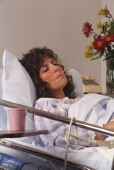
MONDAY, June 11 (HealthDay News) — A new study suggests that sleep doesn’t come easy for many hospitalized patients, with everything from ice machines to traffic to hallway talkers keeping them awake.
The finding, from a small study of 12 healthy people exposed to typical hospital noises, should sound an alarm about the effects of noise on patients’ health.
“Everyone knows that sound disrupts sleep, but in a hospital setting this is a really big problem,” said study lead author Orfeu Buxton, an assistant professor at Harvard Medical School, as well as an associate neuroscientist in the division of sleep medicine in the department of medicine at Brigham and Women’s Hospital in Boston.
“There are noises that are happening all around patients . . . all the time, each of which, one after the other, is disrupting their sleep,” he said. “IV pumps, alarms, phones, the voices of the staff on duty. And exposure to all of this — even at the level of a whisper — can actually accelerate a patient’s heart rate by four or 10 beats a minute.”
All of that can trouble sleep “and cause the kind of enormous patient disruption that can really compromise a patient’s recovery process,” Buxton said.
The findings are published online June 12 and in the June 19 print issue of the Annals of Internal Medicine.
According to the researchers, hospital patients queried in recent surveys often cited noise as a major factor negatively affecting their quality of care.
But what types of noise matter most? To find out, Buxton’s team had a dozen healthy, young men and women spend three nights in a sleep laboratory.
After one night of normal sleep without exposure to noise recordings, all of the participants were then asked to try to sleep while being exposed to recordings of typical hospital sounds. “Internal” noise included gurneys moving down hallways, ice machines, staff conversations, IV drip alarms and phone calls. “External” noises included street traffic and helicopter passings.
Throughout, the participants’ sleep patterns and heart rates were monitored. Predictably, as noise levels went up so did sleep disruption.
Not all noise was equally disturbing, however. The beeps and blips of medical equipment electronics, for example, were found to be more disruptive than people talking or the noise of traffic.
Nevertheless, even a momentary noise disturbance was associated with a bump in heart rate, the team found. This was true while participants were in deep sleep, but it was most problematic when they were in the lightest stage of sleep (so-called REM sleep).
The findings were sadly familiar to one expert.
“Certainly, sleep deprivation and disruption is very common in the ICU [intensive care unit], where I practice most of my medicine,” said Dr. Gulshan Sharma, director of the Medical Intensive Care Unit at the University of Texas Medical Branch at Galveston. He agreed with the study’s list of noise-makers, and said that “all of this contributes to sleep fragmentation and a lack of deep sleep [for patients].”
Buxton’s team noted that the typical hospitalized patient is usually older than those in the study group, and therefore likely to be subject to other non-noise issues that can also affect sleep quality. The issue is real and serious, given that sleep disturbance can prompt or exacerbate a number of serious health issues, including a rise in blood pressure and stress hormones or a dip in immune function and mental health.
Lowering the noise level on wards “would decrease patient stays and improve healing, and perhaps even reduce readmission rates,” Buxton said, and hospitals do have means of doing so.
“Checking vital signs and delivering medicine, for example, can be delivered at the same time to reduce noise disturbance for patients,” he said. “Night workers can be instructed not to speak at full day volume during their shift, because patients are sleeping. Alarms can be going to a central monitoring place, because the intention is, in the first place, to direct them to the staff and not at the patients. And there’s no reason that the phone in the patient’s room should go off at 2 in the morning. That call can definitely wait. Basically, all things we take for granted at home should be the standard in a hospital setting as well,” Buxton explained.
Sharma agreed, especially with regard to centralizing various medical alarms away from the patient. “Using better technology, perhaps that is possible,” he said. “That’s probably where I think the field will be going.”
“If the hospital is a place to heal then it needs to be a quieter environment,” Buxton added. “We’re talking about non-trauma places in a hospital where it would be possible, with some behavior changes by staff as well as in the layout and design of the space, to make the overall environment quieter. It’s certainly a fixable situation.”
More information
There’s more on sleep’s links to health at Harvard University.

